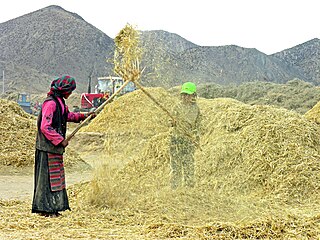Related Research Articles

Tsampa or Tsamba is a Tibetan and Himalayan staple foodstuff, particularly prominent in the central part of the region. It is glutinous meal made from roasted flour, usually barley flour and sometimes also wheat flour. It is usually mixed with the salty Tibetan butter tea. It is also eaten in Turkestan and Mongolia, where it is known as zamba.
Losar also known as Tibetan New Year, is a festival in Tibetan Buddhism. The holiday is celebrated on various dates depending on location tradition. The holiday is a new year's festival, celebrated on the first day of the lunisolar Tibetan calendar, which corresponds to a date in February or March in the Gregorian calendar. In 2020, the new year commenced on the 24th of February and celebrations ran until the 26th of the same month. It also commenced the Year of the Male Iron Rat.

Chhaang or chhyang is a Nepalese and Tibetan alcoholic beverage also popular in parts of the eastern Himalayas, Yakkha, Limbu, Dura, Newar, Sunuwar, Rai, Gurung, Magar, Sherpa, Tamang and Lepcha communities. Among the Lepcha, it is called Chi. It is also known as jaarh in Nepal.

Tibetan cuisine includes the culinary traditions and practices and its peoples. The cuisine reflects the Tibetan landscape of mountains and plateaus and includes influences from neighbors. It is known for its use of noodles, goat, yak, mutton, dumplings, cheese, butter, yogurt, and soups. Vegetarianism has been debated by religious practitioners since the 11th century but is not prevalent due to the difficulty of growing vegetables, and cultural traditions promoting consumption of meat.

A meat pie is a pie with a filling of meat and often with other savory ingredients. They are found in cuisines worldwide.
Dêlêg is a village in Xaitongmoin county of Shigatse Prefecture in the Tibet Autonomous Region of China, northeast of the county seat. The Tibetan name means "good luck". It lies at an elevation of 4,804 metres. In 2007 the village had a population of about 350.
Balep korkun is a type of bread that is consumed mainly in central Tibet. It is round, flat and relatively easy to make. The ingredients are tsampa, water and baking powder. It is cooked in a frying pan. It has been described as similar in appearance to naan.

Chebureki is a deep-fried turnover with a filling of ground or minced meat and onions. It is made with a single round piece of dough folded over the filling in a crescent shape.

The production of beer in Tibet is a relatively recent phenomenon in Tibetan cuisine. The Chinese established the Lhasa Brewery Company in 1988, which is located in Lhasa. It is the highest brewery in the world.
In Tibetan cuisine, Tu is a cheese cake, made with yak butter, brown sugar and water, made into a pastry.
In Tibetan cuisine, Masen is a pastry, made with tsampa, dry cubic or curd cheese, yak butter, brown sugar and water.
In Tibetan cuisine, gyabrag is a pancake, made with barley flour, yak butter, dry cheese curds and sugar.
In Tibetan cuisine, Yurla is a wheat pastry with butter, particularly common in Nyainrong County in northern Tibet.

Highland barley, Tibetan barley or Himalayan barley is the principal cereal cultivated on the Tibetan Plateau, used mainly to make tsampa and liquor (chang).

Pogača is a type of bread baked in the ashes of the fireplace, and later on in the oven, similar to focaccia. Found in the cuisines of the Balkans, it can be leavened or unleavened, though the latter is considered more challenging to make. It is generally made from wheat flour, but barley and sometimes rye may be added. It can be stuffed with potatoes, ground beef, or cheese, and have grains and herbs like sesame, black nigella seed, or dried dill in the dough or sprinkled on top.
Puf Böreği is a deep-fried turnover with a filling of ground or minced meat and onions or peynir and parsley, dill.
References
- ↑ Li, Tao; Jiang, Hongying (2003). Tibetan customs. 五洲传播出版社. p. 37. ISBN 978-7-5085-0254-0 . Retrieved 5 August 2011.